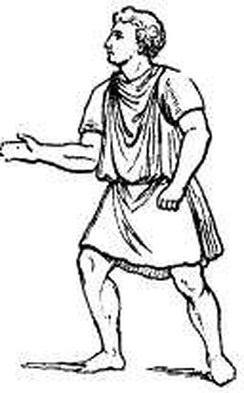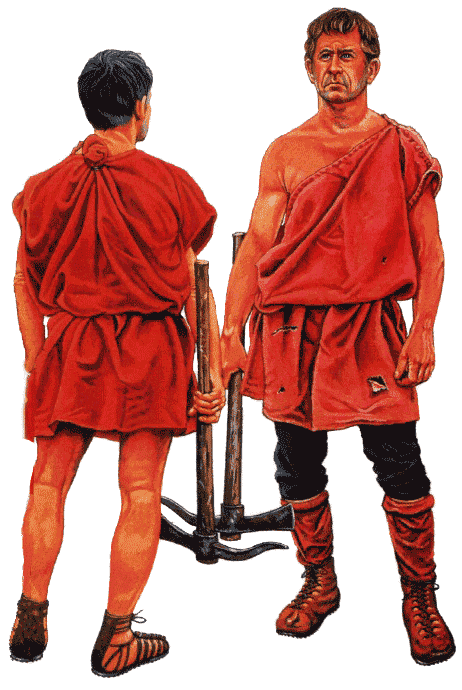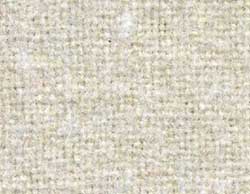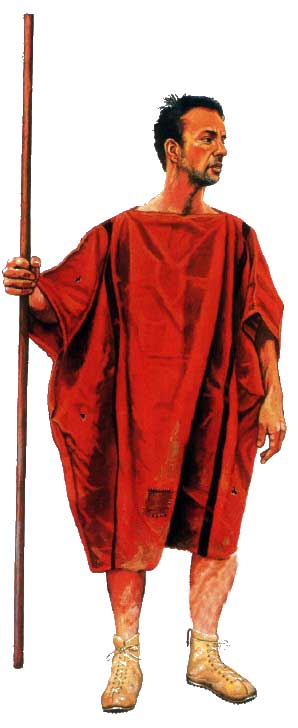Tunica (tunic)
 The basic item of Roman military clothing was the tunica. In the 1st Century AD, tunics appear to have been made from
The basic item of Roman military clothing was the tunica. In the 1st Century AD, tunics appear to have been made from  two rectangular pieces of cloth woven to the desired dimensions (i.e. with selvedges on all four edges) and sewn together at the sides and shoulders (Graham Sumner, Roman Military Clothing, 20). Openings were left for the arms and head. The cloth extended beyond the shoulders and covered the upper arms. The military tunica was shorter than the civilian style in that it ended above the knees when it was pulled up under the belt; tunics for male civilians usually covered the knees.
two rectangular pieces of cloth woven to the desired dimensions (i.e. with selvedges on all four edges) and sewn together at the sides and shoulders (Graham Sumner, Roman Military Clothing, 20). Openings were left for the arms and head. The cloth extended beyond the shoulders and covered the upper arms. The military tunica was shorter than the civilian style in that it ended above the knees when it was pulled up under the belt; tunics for male civilians usually covered the knees.
Although tunics were made in different sizes to fit different individuals, they were usually very wide and wider than they were long. leaving a lot of excess material at the sides which gave tunics the baggy appearance depicted on period sculpture (Sumner, 27-28, 30-33).
Color
 There is a big disagreement among both scholars and reenactors, as to the color of Roman military tunica, or whether different colors were worn by differing units or military ranks, or for different occasions. Sumner lists all of the known evidence for the colors of military clothing arranged in chronological order (pages 121-32). What evidence exists for the First Century AD, suggests that Roman legions wore red dyed tunics for war, white tunics for formal occasions such as parades, and undyed tunics for other uses.
There is a big disagreement among both scholars and reenactors, as to the color of Roman military tunica, or whether different colors were worn by differing units or military ranks, or for different occasions. Sumner lists all of the known evidence for the colors of military clothing arranged in chronological order (pages 121-32). What evidence exists for the First Century AD, suggests that Roman legions wore red dyed tunics for war, white tunics for formal occasions such as parades, and undyed tunics for other uses.
Some reenactor units, following this evidence, wear tunica that are either dyed with madder or a modern deep red dye that approximates what could be achieved with madder for all military activities. White tunica with clavi could be worn for parties or special scenarios, while an undyed tunica would have been worn for fatigue work or off-duty wear.
Dimensions:
There are many theories on the size, but in Graham Sumner's book, Roman Military Clothing I, he states it would be big and baggy, ca. 55 wide x 61 inches long. These dimensions come from original instructions, in an order placed for tunica — yes, it is huge, no, you don't have to make yours thusly, but why not?? Also, with this larger size, one would gain more padding under the lorica…
A FORM OF PUNISHMENT...
 As the tunica and belt were important for recognizing a soldier, one form of punishment for a miles was public humiliation by him making him stand around the front gate of the castra with his tunica unbelted, as shown here.
As the tunica and belt were important for recognizing a soldier, one form of punishment for a miles was public humiliation by him making him stand around the front gate of the castra with his tunica unbelted, as shown here.
Notes:
Depictions on Trajan's columns of soldiers doing work fatigues indicate that the tunic could be worn with the right arm protruding from the neck slit to bare the shoulder. This means the neck slit was larger than what is often suggested. The method to narrow the neck slit when not doing fatigues is also indicated on Trajan's column: fabric behind the neck was bunched up and tied off with a cord. Experiments with tunics designed and worn this way show that this not only narrows the neck slit but also makes the front of the slit hang down lower, as well as produce the draping effect portrayed in sculpture (Sumner, 36-36, 40).




















